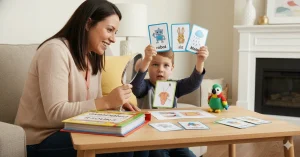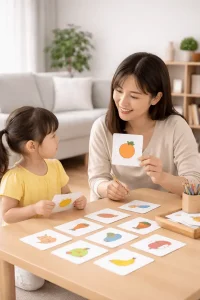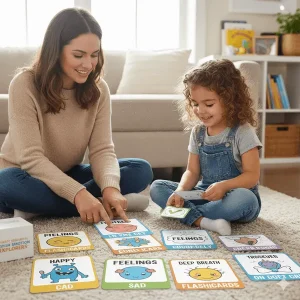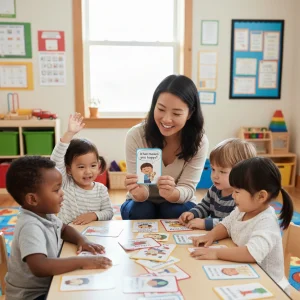Breaking Down Natural Language Acquisition for Beginners
By Wellness Hub
Last Updated: August 1, 2024
Ever wonder how children naturally learn to speak and communicate? Watching a child go from babbling to forming sentences can be both fascinating and mysterious. You might wonder why some children speak in full sentences right off the bat while others seem to take their time, using bits and pieces of language. That’s where understanding Natural Language Acquisition (NLA) comes in.
Understanding Natural Language Acquisition
Definition
Natural Language Acquisition (NLA) is the innate ability children have to learn language. Every child is born with a unique capacity to communicate, and this process begins from the moment they first cry. They progress through stages, starting from crying and cooing to babbling, forming sentences, and finally expressing their needs effectively.
Language Development Process:
Language acquisition begins naturally as children listen to their environment. Their early attempts at communication include making sounds and vocalizations to indicate their needs. Over time, they start picking up words, phrases, and eventually sentences.
Child Language Learning:
As children grow, their vocabulary expands rapidly. Around the age of one, they start recognizing familiar words and can associate them with objects or actions. By two years old, most children can put together simple two-word phrases like “more juice” or “big truck.” These combinations gradually become more complex, eventually leading to full sentences.
Also read: Early Identification/ Warning Signs in child development
Native Language Acquisition vs. Second Language Acquisition:
Native Language Acquisition:
This refers to the process by which children learn their first language naturally. They rely on listening to and mimicking the language of those around them. It’s largely unconscious and based on exposure.
Second Language Acquisition:
Learning a second language often involves a more conscious effort, especially for adults. However, children who grow up in bilingual households can naturally acquire both languages simultaneously.
Key Takeaways for Parents and Educators
Recognize Progress:
Every child follows a unique trajectory in language development. Celebrate their milestones and understand that each stage builds a foundation for the next.
Provide Exposure: Create a language-rich environment by reading stories, singing songs, and engaging in conversations.
Identify Challenges Early:
If you notice significant delays in language development, consider reaching out to experts for guidance. Wellness Hub has a range of resources available, including assessments and speech therapy programs.
Know more: Speech and Language Milestones: 0 to 12 Months
Analytical Language Processing
Definition & Characteristics
Analytical Language Processing is a linear progression through which children naturally acquire language. It starts with sounds and gradually advances to single words, phrases, and sentences. Each stage builds on the previous one, helping children develop their linguistic skills step by step.
Example Progression
- Single Words: “Dog!”
- Two-Word Combination: “Mommy, dog!”
- Simple Sentence: “Look, Mommy, dog!”
- Complex Sentence: “Look, Mommy, I see a dog!”
Stages of Analytical Language Processing

- Single Words
Children begin by using single meaningful words like “milk” or “dog.” These words represent their immediate needs or interests.- Example: “Milk” ➡️ “Dog”
- Two-Word Combinations
As their vocabulary grows, they start combining two words to form simple phrases.- Example: “More milk” ➡️ “Big truck”
- Sentences
Once they are comfortable with simple phrases, they start constructing grammatically correct sentences.- Example: “I want more milk” ➡️ “Look, a big truck!”
- Intonation
Finally, they develop proper speech intonation, adding rhythm and emphasis to their sentences. This helps them convey emotions and intentions more clearly.- Example: “I want more milk!” (rising intonation for excitement)
- Example: “No, I don’t like it.” (falling intonation for disapproval)
Know more: Speech and Language Milestones – 1 to 2 years
Tips for Supporting Analytical Language Processors
- Encourage Word Combinations: Prompt your child to combine words by offering options like “more juice” or “big truck.”
- Expand Their Vocabulary: Introduce new words through reading stories, singing songs, and describing everyday activities.
- Model Correct Sentences: Use proper grammar and structure when speaking to your child to help them learn correct sentence formation.
Gestalt Language Processing
Definition & Characteristics
Gestalt Language Processing is a distinct way in which children acquire language. Unlike Analytical Language Processing, where children learn individual words first, Gestalt processors learn in “chunks” or gestalts. They often use echolalia, repeating phrases they’ve heard in shows, songs, or conversations.
Example Progression
- Whole Phrase: “Old McDonald had a farm E-I-E-I-O.”
- Partial Phrase: “Had a dog.”
- Single Words: “Dog.”
- Original Sentence: “I see a dog!”
Stages of Gestalt Language Processing
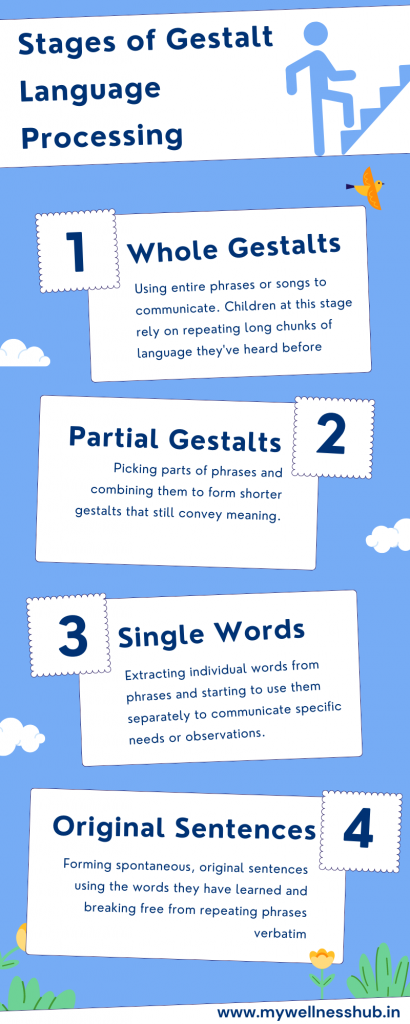
- Whole Gestalts
In this stage, children use entire phrases or songs to communicate their needs.- Example: “Old McDonald had a farm E-I-E-I-O.”
- Partial/Mitigated Gestalts
Here, children pick parts of phrases and combine them with others.- Example: “Had a dog.”
- Single Words
They start extracting individual meaningful words from the phrases they used.- Example: “Dog.”
- Original Sentences
Finally, they form spontaneous, original sentences.- Example: “I see a dog!”
Explore more: Echolalia in Language Development: Strategies for ASD Support
Tips for Supporting Gestalt Language Processors
- Model Phrases in Relevant Contexts: If your child says, “I’m thirsty,” model “Do you want water or juice?”
- Provide Choices: Help them express their true needs by giving options like “Are you thirsty, or do you need a break?”
- Identify the Meaning Behind Gestalts: Observe the context in which your child uses phrases to decode their intention.
- Celebrate Progress: Recognize and praise your child when they move from gestalts to original sentences.
Comparing Analytical and Gestalt Language Processing
Analytic Language Development
Analytic Language Development follows a linear progression from sounds to sentences. Children start with single words and build up to more complex structures. They focus on individual words and gradually combine them to form phrases and sentences.
Example Progression
- Single Word: “Milk”
- Two-Word Combination: “More milk”
- Sentence: “I would like more milk, please.”
Gestalt Language Development
In Gestalt Language Development, children focus on repeating whole phrases or sentences rather than starting with individual words. They rely on intonation and melody to convey meaning.
Example Progression
- Whole Phrase: “I need to go out” (repeated verbatim)
- Partial Phrase: “Go out”
- Single Word: “Out”
Explore more on our article Is My 3-4 Year Old Talking Enough? A Parent’s Guide to Milestones
Differences Between Analytical and Gestalt Language Processing
- Individual Words vs. Whole Phrases:
- Analytic processors focus on individual words and build sentences from them.
- Gestalt processors focus on whole phrases and break them down into words later.
- Linear vs. Non-Linear Progression:
- Analytic processing is a step-by-step, linear process.
- Gestalt processing involves a non-linear progression from phrases to words.
- Grammar vs. Intonation:
- Analytic processors emphasize grammar and structure.
- Gestalt processors rely on intonation and melody to express meaning.
Supporting Both Language Processing Styles
- Analytic Processors:
- Encourage vocabulary expansion by introducing new words and phrases.
- Read books and sing songs to help them grasp sentence structure.
- Gestalt Processors:
- Model contextually relevant phrases to help them understand meaning.
- Provide choices and identify intent to decode whole gestalts.
Identifying Your Child’s Language Processing Style
Understanding your child’s language processing style is crucial for providing the right support. Let’s explore the signs of both analytic and gestalt language processors so you can identify your child’s natural language acquisition journey.
Analytic Language Processor Signs
- Uses Individual Words: They tend to start with single words like “milk” or “dog” before moving to phrases and sentences.
- Example: “Dog,” “Mommy dog,” “Look, Mommy, I see a dog!”
- Builds Sentences Gradually: Their sentences evolve progressively from two-word combinations to grammatically correct sentences.
- Example: “More milk” ➡️ “I want more milk, please.”
- Adds to Vocabulary Over Time: They expand their vocabulary step by step, picking up new words regularly.
- Example: “Car,” “Big car,” “Look, a big car!”
Gestalt Language Processor Signs
- Uses Delayed Echolalia: They often repeat phrases or sentences they’ve heard in shows, books, or conversations.
- Example: “I will save you!” (from a superhero cartoon)
- Repeats Entire Phrases/Songs: Instead of single words, they use whole phrases or songs to communicate.
- Example: “Old McDonald had a farm E-I-E-I-O.”
- Uses More Intonation or Melody in Speech: They focus on the rhythm and melody of language rather than its grammar.
- Example: “I need to go out!” (intonation and melody convey excitement)
How to Support Your Child’s Language Processing Style
- Analytic Language Processors:
- Encourage vocabulary expansion through reading and interactive games.
- Model sentence structure by expanding on their phrases.
- Gestalt Language Processors:
- Model phrases in relevant contexts to help them understand intent.
- Provide choices to decode their echolalia.
Supporting Your Child’s Natural Language Acquisition Journey
Tips for Analytical Language Processors
- Encourage Word Combinations
When your child uses a single word like “milk,” gently prompt them to combine it with another word, such as “more” or “please.”- Example: “More milk,” “Milk please,” “More milk, please.”
- Read Stories and Ask Questions
Reading stories introduces new vocabulary and helps children understand sentence structure. After reading, ask questions to encourage language use.- Example: “What is the boy doing with the dog?”
- “Who else do you see in this picture?”
For Gestalt Language Processors
- Model Phrases in Relevant Contexts
Listen for the phrases your child uses and model new ones in the right context.- Example: If your child says, “I’m thirsty,” model “Do you want water or juice?”
- Provide Choices and Identify Meaning
Offer your child choices to help them express their true needs. Decode the meaning behind their echolalia and provide contextually appropriate vocabulary.- Example: “Are you thirsty, or do you need a break?”
Tips for Supporting Your Child’s Natural Language Acquisition Journey
| Language Processor Type | Tips | Example |
|---|---|---|
| Analytical | Encourage Word Combinations | “More milk,” “Milk please” |
| Gradually prompt children to combine words to make simple phrases. | ||
| Read Stories and Ask Questions | “What is the boy doing with the dog?” | |
| Introduce new vocabulary through storytelling and ask questions to encourage responses. | ||
| Model Correct Sentence Structure | “Let’s go play at the park.” | |
| Use grammatically correct sentences to help them grasp structure. | ||
| Expand Their Vocabulary | “This is a big red truck.” | |
| Introduce descriptive words to broaden their vocabulary. | ||
| Celebrate Progress | “You said ‘I want more juice!’ Great job!” | |
| Recognize and praise them when they combine words or use new phrases. | ||
| Gestalt | Model Phrases in Relevant Contexts | “Are you thirsty, or do you need a break?” |
| Listen for the phrases your child uses and model new ones in the right context. | ||
| Provide Choices to Identify Meaning | “Do you want water or juice?” | |
| Offer choices to help them express their needs and decode the meaning behind their echolalia. | ||
| Celebrate Progress | “Great job saying ‘I want juice!'” | |
| Recognize and praise when they move from gestalts to original sentences. | ||
| Offer Contextually Relevant Vocabulary | “We’re going to have spaghetti for dinner.” | |
| Provide words that match the activities or items they refer to in their echolalia. | ||
| Create a Language-Rich Environment | “Let’s sing ‘Old McDonald had a farm’ together!” |
Strategies for Parents
- Model Language
Provide contextually appropriate vocabulary and use simple sentences that your child can understand and repeat.- Example: “It’s time to eat lunch.” ➡️ “Lunch time!”
- Celebrate Progress
Recognize and celebrate your child when they use new words or phrases.- Example: “Wow! You said ‘more juice!’ Great job!”
- Create a Language-Rich Environment
Engage with your child using songs, stories, and conversations. Expose them to different vocabulary through books, games, and activities.- Example: Sing nursery rhymes together or describe the activities during a walk in the park
Conclusion
Whether your child is an analytic or gestalt processor, it’s crucial to support them through their natural language acquisition journey. Every child learns language at their own pace, so understanding their unique way of processing language can make a big difference. Celebrate each milestone, and create a language-rich environment where your child feels encouraged to explore words, phrases, and sentences.
If you’re looking for more help or tips, Wellness Hub has valuable resources and expert advice to help your child thrive. Check out our Comprehensive Guide to the Benefits of Speech Therapy or learn about our tailored Pediatric Speech Therapy Program. If your child has specific challenges, explore our articles on Receptive Language Disorder and Types of Aphasia to find more helpful information.
Frequently Asked Questions:
1. What is Natural Language Acquisition?
Natural Language Acquisition (NLA) is the innate ability children have to learn language. It starts from infancy with crying and cooing, progressing to babbling, words, phrases, and eventually forming sentences to express their needs.
2. How do children naturally acquire their first language?
Children naturally acquire their first language by listening to those around them. They start by making sounds, then gradually learn words, phrases, and sentences through interaction with parents, peers, and their environment.
3. What is the difference between Analytical and Gestalt Language Processing?
Analytical Language Processing is a linear progression from sounds to sentences, focusing on individual words. Gestalt Language Processing involves learning in “chunks” or phrases, often using echolalia (repeating phrases heard in conversations or shows).
4. How does Analytical Language Processing work?
Analytical Language Processing starts with single words like “milk” or “dog,” then builds to two-word combinations, phrases, and grammatically correct sentences. It’s a step-by-step process where children gradually expand their vocabulary.
5. What are the stages of Gestalt Language Processing?
The stages of Gestalt Language Processing include:
- Whole Gestalts: Using entire phrases or songs to communicate.
- Partial/Mitigated Gestalts: Picking parts of phrases and combining them.
- Single Words: Extracting individual words from phrases.
- Original Sentences: Forming spontaneous, original sentences.
6. How can I identify my child’s language processing style?
If your child uses individual words and builds sentences gradually, they’re likely an analytic processor. If they often use delayed echolalia (repeating phrases from shows or conversations), focus on whole phrases, and use more intonation, they’re probably a gestalt processor.
7. How can I support my child’s Natural Language Acquisition journey?
Here are some tips for supporting your child’s language development:
- Analytic Language Processors:
- Encourage word combinations like “more milk.”
- Read stories and ask questions.
- Gestalt Language Processors:
- Model phrases in relevant contexts.
- Provide choices and identify meaning.
8. What are some natural language acquisition strategies for parents?
- Model Language: Provide contextually appropriate vocabulary.
- Celebrate Progress: Recognize when your child uses new words/phrases.
- Create a Language-Rich Environment: Engage with your child using songs, stories, and conversations.
9. Where can I find expert advice and resources for my child’s language development?
Wellness Hub offers valuable resources and expert advice to help your child thrive. Check out our Comprehensive Guide to the Benefits of Speech Therapy and our Pediatric Speech Therapy Program.
10. What are the differences between Native Language Acquisition and Second Language Acquisition?
- Native Language Acquisition is the process by which children naturally learn their first language. It occurs unconsciously through exposure and interaction with family and peers.
- Second Language Acquisition typically involves a more conscious effort, often through formal education or structured learning, especially for adults. Children raised in bilingual households can naturally acquire both languages simultaneously.
About the Author:
Anuradha Karanam
Speech-language pathologist (7+ years of experience)
Anuradha Karanam is a skilled speech-language pathologist with over 6 years of experience. Fluent in Tamil, Telugu, Hindi, and English, she specializes in parent counseling, speech sound disorders, fluency assessment, and speech-language evaluations. Anuradha excels at working with children with developmental disorders, offering creative and effective therapy programs. Currently at Wellness Hub, she holds a BASLP degree and is registered with the RCI (CRR No A85500). Her patience, ambition, and dedication make her a trusted expert in her field.
Connect with Anuradha to learn more about how she can help you or your loved one find their voice.
Book your Free Consultation Today
Parent/Caregiver Info:
Client’s Details:
* Error Message

